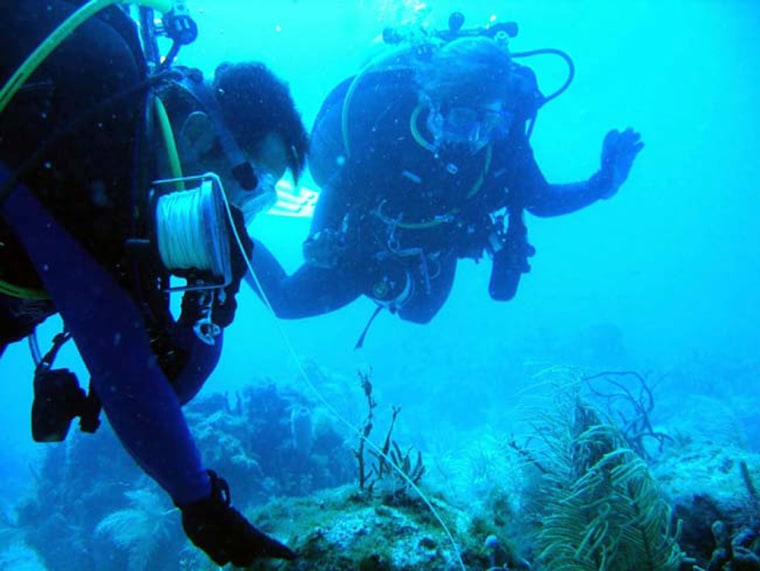NASA astronauts and a biomedical engineer have sunken to new depths to test out equipment bound for the International Space Station (ISS).
Led by veteran astronaut John Herrington, the NASA crewmembers are in the middle of a 10-day mission on the ocean floor aboard Aquarius, an undersea research station off the coast of Key Largo, Florida. During their stay, the team is conducting spacewalk-like diving excursions and field-testing a variety of biomedical equipment designed to help astronauts living aboard the ISS.
"The similarities with space flight go far beyond training," said Herrington, commander of the Aquarius mission, from the undersea facility. "This is a relatively safe environment to test and use [space] hardware."
In addition to Herrington, who flew aboard space shuttle Endeavour in 2002 and helped build the space station, NASA astronauts Doug Wheelock and Nick Patrick, and biomedical engineer Tara Ruttley round out the current Aquarius crew. Together, they make up the "aquanaut" NASA Extreme Environment Mission Operations 6 (NEEMO 6) mission.
The Aquarius Undersea Research Station is owned by the National Oceanographic and Atmospheric Administration (NOAA) and operated by the University of North Carolina at Wilmington (UNCW). At a depth of 67 feet below the ocean's surface, the facility is 13 feet wide (4 meters) and 45 feet long (13.7 meters), or about the size of the space station's Russian Zvezda module. UNCW systems engineers Craig Cooper and Joe March will work alongside the NEEMO 6 crew during their mission.
Diving for biology
Unlike the last NEEMO mission, which focused on life sciences, NEEMO 6 is dedicated to biomedical engineering. Wireless devices to measure the health of individual crewmembers and a new piece of exercise equipment are just some of the items to be tested during the crew's stay aboard Aquarius.
"The engineering hardware that is being tested in this extreme environment will probably fly in the near future," said Bill Todd, NASA's NEEMO project manager. "So Aquarius is a good place for optimizing the performance of new hardware."
Inside the undersea facility, NEEMO 6 crewmembers are wearing wireless tracking devices similar to those used in hospitals to find doctors and emergency equipment during a crisis. The aquanauts are also using individual wireless physiological monitors to determine how the commercially available devices perform inside a metal-walled habitat. A portable bone scanner, designed to measure bone density changes during long-duration space missions, is also among the technology under scrutiny.
"This is the best situation I can think of for this type training," Ruttley told SPACE.com during a videoconference. "It's very important to have a closed environment…to be secluded and test this hardware."
Each day, Ruttley and her crewmates use a device called the Constant Force Resistive Exercise Unit (CFREU). The instrument is designed to be a simple, lightweight exercise alternative for the ISS, applying constant force to muscle groups over the entire range of motion.
A space vision trainer
The real-time crew isolation offered by Aquarius' undersea location is a prime resource for both NEEMO aquanauts and NASA, which will have to scrape as much long-duration astronaut training as it can muster to fulfill its vision of future manned missions to the moon, Mars and beyond.
"We're in the planning stages for a future, potentially longer mission aboard Aquarius," Todd said, adding that such excursions could be an effective trainer for extended ISS tours or future expeditions other moons and planets. "We've long been an ISS analog, but we have every capability and desire to be more if that's the direction that NEEMO can go."
An international NEEMO crew, with Canadian and NASA astronauts working side-by-side, is expected to dive down to Aquarius in October, Todd added.
Meanwhile, the NEEMO 6 aquanauts are reaching the midpoint of their undersea excursion and have adjusted to the fishy liveliness of the facility's aquatic habitat. They are expected to return to the surface - called "splash up" - on July 21.
"It's a fabulous place," said Herrington of the ocean bottom, adding that it's nice to be able to look out the window and see living things swim by. "You can't see that in space…if I did, I'd probably have to take a second look."
